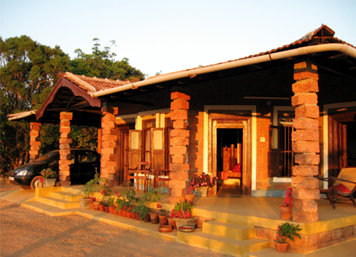Every home is born first in the imagination, in the longing for the culmination of a dream. Only in some homes, the dream like quality never really leaves long after the walls have sprung up and every roof tile, every brick, pillar and window has found its place. The first time you see the Jade Hill cottage in Coorg, it is easy to disbelieve your eyes. So is there a house, really, atop a steep hill, shining in the evening wilderness like a jewel? Well, yes, there really is. But before we trek towards the home, it is time for a flashback. As narrated by architect Kavya Thimmaiah Prasanna, “My dad (Rajyutsva award winning architect HC Thimmaiah) was orphaned at an early age. He and his three siblings spent their childhood between various relatives’ houses in Coorg, the one constant being their grandmother. Her death split up the family and Dad moved to Delhi, then Mumbai and finally to Chennai for his first job. One of the first architects to come from Coorg, he finally moved to Bangalore where he set up his own practice and started his life. But always, there was a hankering for what he had lost. The childhood home among the coffee plantations, that he enjoyed so fleetingly. So 40 years after he had left Coorg, when he got the opportunity to build a hill home, it was the culmination of a life-long dream, something he had always yearned for, without even admitting to it.”
**
So that then is the history of Jade Hills, the house on top of the mountain that HC Thimmaiah built with his daughter. The cottage when you reach it , spreads out languidly as if it were part of the hill rather than built on it. And that is because the Thimmaiahs used stone and laterite found in the region and kept the structure organic and simple with a wrap- around verandah where the design quirk is the twisted brick pillars. The flooring throughout the house is red oxide though it isn’t just red but blue and yellow and green and embedded with decorative tiles.
**
Part of recreating nostalgia was to literally salvage it so HC Thimmaiah sourced doors and windows and a lot of wood and even tiles from old traditional homes that are being demolished all across Coorg. Kavya says, “Yes, my parents decided to use only recycled materials in the construction. Scrap-yards were scoured and doors, windows and pillars were bought in a decrepit state and refurbished lovingly. Hundred-year old tiles for the roof and burnt- orange, laterite walls completed the construction.” To keep the house green as much as possible, the use of new wood has been kept to the minimum and concrete built-ins have been created to serve as beds while a few pieces of antique furniture lend a sense of history to the place. Kavya shares, “Some of the pieces were found in a corner of a dusty furniture shop.”
**
Even in the bathroom, a mosaic was created out of broken tiles that would have been thrown otherwise. Building the house though was not easy. Recalls Kavya, “When my parents bought a piece of land in this remote, relatively unknown part of Coorg, most people thought that they were plain crazy. Who would want to live in a village so windy that it was called Galibeedu or `Windy Village?’ A place with rainfall so high, that nothing grew on the slopes? Least of all, that Coorg staple, coffee? To a Kodava, any land that coffee couldn’t be grown on, is considered pretty much useless. ”
‘If you must build a house there, don’t build on top-of-the hill,” they said and added, ‘Build it in the valley, where it is sheltered and to hell with the view!” Kavya smiles, “But my dad, the recalcitrant person that he is, said, `Top of the hill and nowhere else.” So top-of- the hill it was. A house built into the hillside, overlooking the valley, with a deck facing a storybook view and breath-taking sunsets.”
**
Most visitors, recalls Kavya couldn’t locate the house at first, “This house with the old doors and windows, with the weather-beaten look, couldn’t be it, they thought. One visitor even went around the back, searching for the ‘new’ house till we had to tell him that this was it! Many years and monsoons later (there were dire warnings of monsoons so severe that they would blow the tiles off the roofs), the house stands as proudly as before, belying all detractors. Resorts and home stays have sprung up in and around Galibeedu and this once forgotten place now commands one of the highest, real-estate values in Coorg. For us, the house on the hill has become a favourite family getaway. Sitting on the deck, watching the sun set over the green forests below, we can’t imagine building the house anywhere else.”
**
But more than just making an architectural statement, the house, says Kavya, represents the history of a man, “who left Coorg penniless, and returned proudly to re-claim a part of it. On his terms, beholden to no one.”
**
Reema Moudgil has been writing for magazines and newspapers on art, cinema, issues, architecture and more since 1994, is an RJ, hosts a daily Ghazal show, runs unboxed writers, is the editor of Chicken Soup for The Indian Woman’s soul, the author of Perfect Eight (http://www.flipkart.com/perfect-eight-9380032870/p/itmdf87fpkhszfkb?pid=9789380032870&_l=A0vO9n9FWsBsMJKAKw47rw–&_r=dyRavyz2qKxOF7Yuc ) and an artist.







You have brought out the passion & love that went into this house so beautifully. Thank you Reema for doing what you do so well!